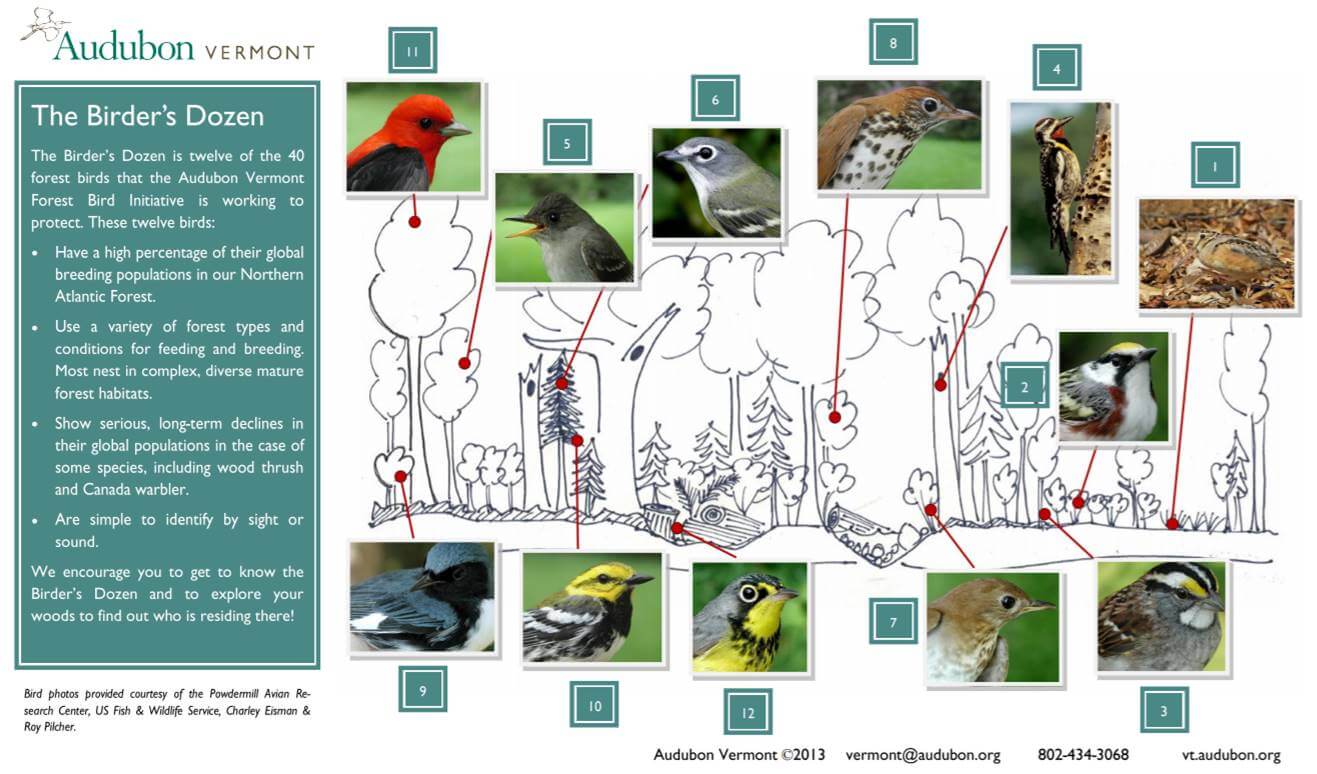Foresters for the birds

In 2008, Audubon Vermont and the Vermont Department of Forests, Parks and Recreation teamed up to create a program called “Foresters for the Birds.” The idea of this program was that, while there is a lot to love about Vermont’s forests—from the way they make our state so beautiful, clean our air and our water, and support our local communities and economies with renewable forest products and awesome recreational opportunities—many people especially love, value and connect with birds. Foresters for the Birds sought to highlight how forests support rich, diverse populations of birds and how good forest management can support and improve habitat for them. This program has been so successful that it has been expanded to other states in the northeast and is under development in the Southeast and Pacific Northwest.
As part of this project, a list of birds called the Birder’s Dozen was created. These are 12 charismatic and easily identifiable birds with a range of habitat requirements. Keeping an eye and an ear out for the Birder’s Dozen helps you identify whether or not your area features the diversity of habitat types and conditions required by most of Vermont’s birds. The list ranges from American woodcock, which need young forest, forest openings and alder wetlands, to scarlet tanager, which requires mature forest, to the eastern wood-peewee, which requires canopy gaps and a dense understory.
Vermont and the surrounding region host one the most diverse breeding bird populations in the United States—more than 80 species! This includes both year-round occupants and neo-tropical migrants—birds that overwinter in the tropics and migrate to Vermont to breed in the summer. According to a 2017 report by the Vermont Center for Ecostudies, bird populations in Vermont have declined by 14.2 percent over the last 25 years, including much more precipitous declines in several species. Forest fragmentation, parcelization and loss, invasive exotic species and climate change are among the many factors contributing to this decline.
So how do we encourage great bird habitat? First, we protect our forests. Forest and ecosystem loss and the fragmentation of large areas of forest into smaller pieces by roads and development are fundamental threat to our birds. Conserving forests and protecting them with smart planning and zoning rules in your communities is a good place to start.
Next, manage for diverse, complex forests. As illustrated by the Birder’s Dozen, some species of birds need a dense canopy, canopy openings (gaps) filled with young trees and shrubs, large areas of early successional forest and forests with trees of all different sizes and ages. We call this type of diversity—trees growing in different ways—structural diversity. Species diversity—trees of all different species—is also critical, because different birds use different tree species for foraging, nesting, shelter and more.
Another thing we can do for our birds is to make sure we keep some big, old trees in our forests. Big trees have many ecological benefits, including providing habitat for all different kinds of birds, from those like nuthatches who forage for arthropods in their deep bark cracks to pileated woodpeckers and owls that nest only in cavities in trees more than 20 inches in diameter.
We also need to recognize the importance of dead and imperfect trees in our forest. Dead-standing trees (snags), cavity trees, fallen trees and dead wood on the forest floor all provide important bird habitat. The ruffed grouse, for instance, needs fallen logs to drum on, and many other bird species use downed wood for cover, foraging, nesting and singing perches. While you may curse the woodpeckers that put holes in your trees, these living and dead cavity trees are often called wildlife motels, providing nesting and denning sites for a wide range of birds and mammals.
If you’ve read my previous articles you know that the value of complex forests with big trees and lots of dead wood is not limited to birds. Forests like this are also more like the old growth forests that once covered much of our state. They store lots of carbon and are resilient and adaptive to climate change. They provide habitat for a huge range of wildlife, from birds and bats to moose and black bear. Responsible forest management with birds in mind can protect and enhance the value of our forests for the birds that we love while making Vermont’s forests holistically healthier in the process.
You can learn more about Foresters for the Birds at Vermont Audubon.
Ethan Tapper is the Chittenden County Forester. He can be reached by email or by phone at (802) 585-9099.

